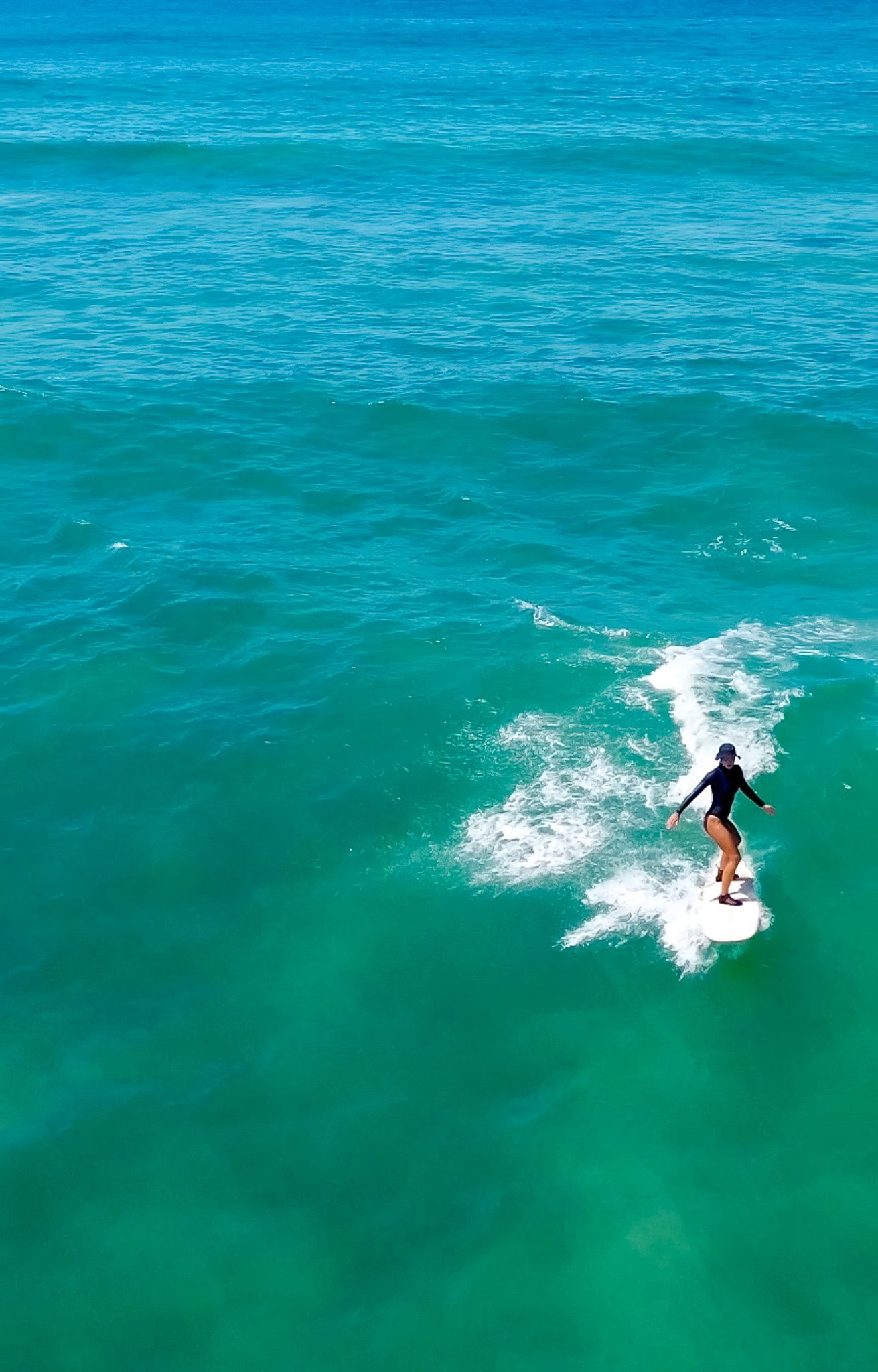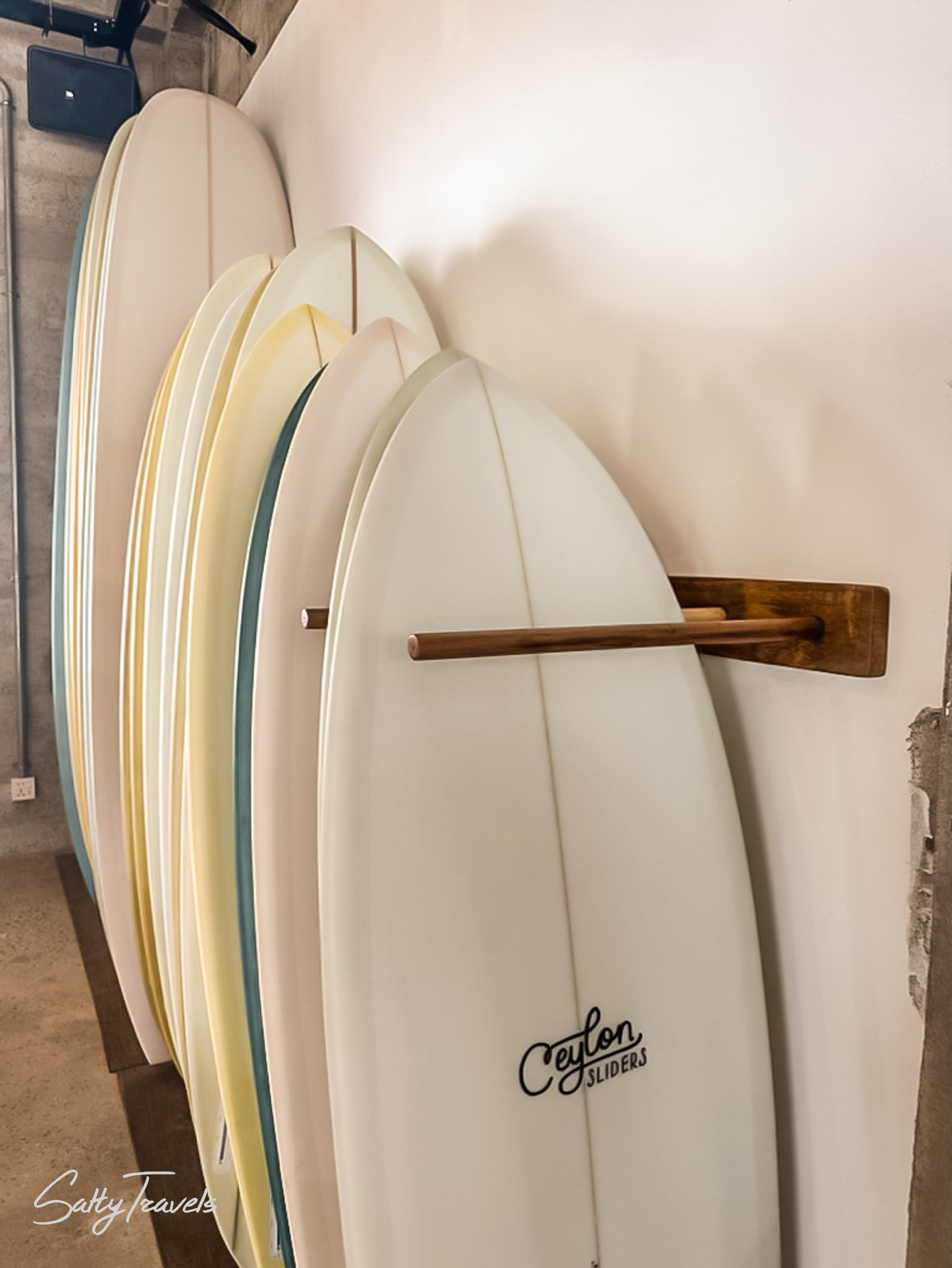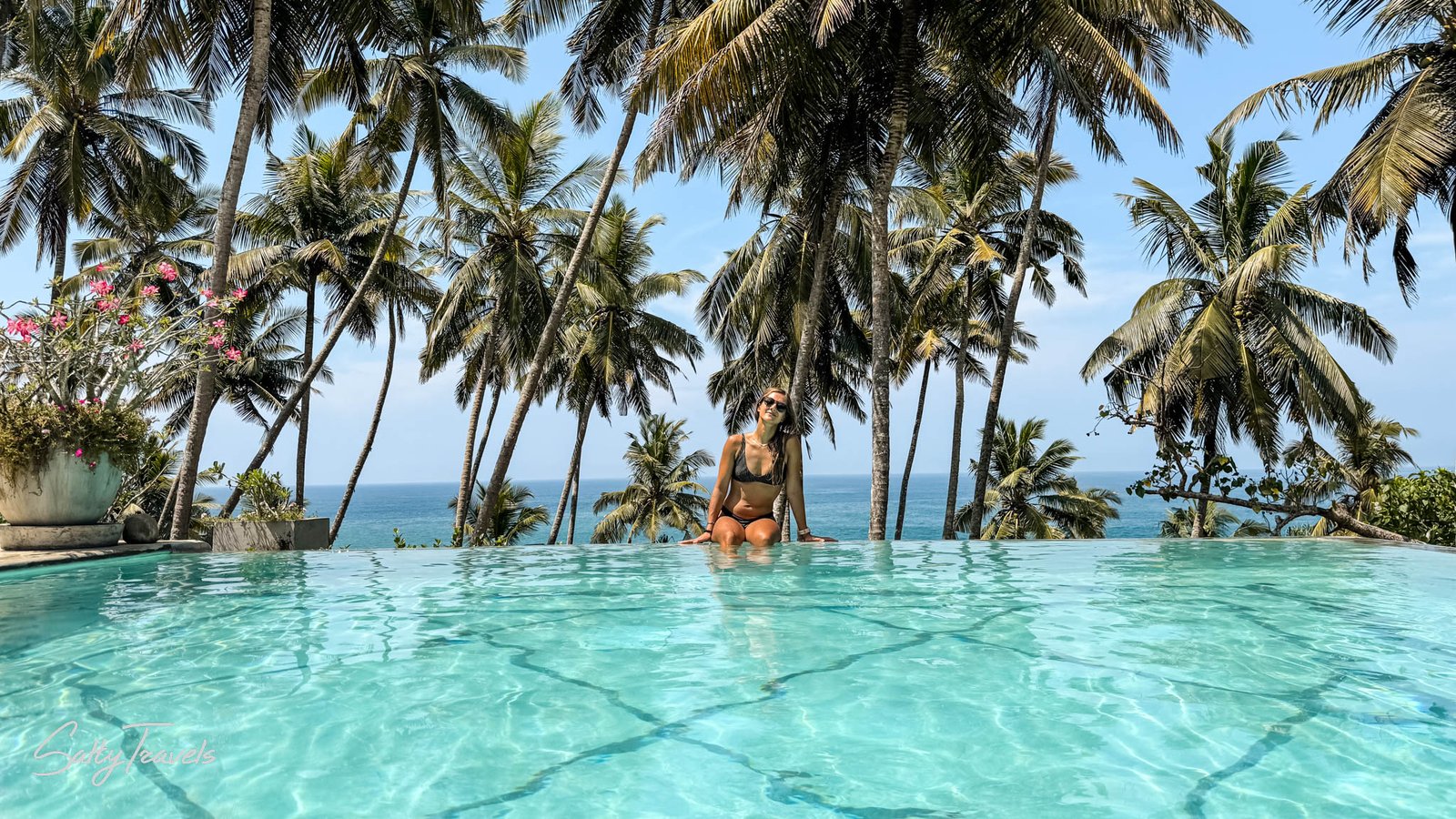Ahangama is a dream destination for surfers looking to ride consistent, mellow, and forgiving waves. This makes surfing in Ahangama best for intermediate surfers and longboarders, offering the perfect balance between fun and challenge.
We spent three months in Ahangama as digital nomads, surfing almost every day. And guess what? In peak season, at least one surf spot is always working, so if you’re planning a surf trip to Sri Lanka, Ahangama should definitely be on your radar.
In this comprehensive surf guide, I break down everything you need to know about surfing in Ahangama – from the best surf spots to the ideal season, plus a few insider tips to make the most of your time in the water.
Table of Contents
When to Surf in Ahangama: Best Season for Perfect Waves
Ahangama is on Sri Lanka’s southwest coast, which means the best surf season runs from November to March/April. This also happens to be the island’s dry season, so you can expect plenty of sunshine and clean conditions.
Technically, the high season ends in March, and by April, you might get some occasional rain and slightly bigger, more powerful waves. But here is the thing – April is also the month when we experienced the least crowds in the water. If you don’t mind a little unpredictability, it’s a great time to surf without the peak-season crowds.
⚠️ Warning! In late March and April, Ahangama can experience sudden weather changes due to the shift from the dry season to the southwest monsoon. This period, known as the First Inter-Monsoon, often brings unpredictable swells, strong currents, and occasional storms. Conditions in the ocean can become dangerous quickly, even for experienced surfers. Always check the forecast, talk to locals, and avoid going out alone during uncertain conditions.
Best Surf Spots in Ahangama for Longboarders & Intermediate Surfers
Every morning before work, we’d hop on our scooters and do a little surf check along Ahangama’s best surf spots. From Sticks to Lazy Right and Lazy Left in Midigama, you can check all of them within a 10-minute drive. No bumpy off-road missions required – all the surf breaks are super easy to access since they’re located right along the main road.
We rarely even checked the tide because we had limited time to surf before noon (work calls!). And yet, we always found a spot that was working. Another pro tip? Mornings are usually the best time to surf in Ahangama, especially in the dry season. By afternoon, the wind tends to pick up, making conditions a bit trickier.
Ahangama offers a solid variety of reef breaks. They are perfect for longboarders and intermediate surfers. You can practice nose rides, cross-steps, or simply catch more green waves – without the risk of getting completely destroyed and traumatized when something goes wrong.
1. Marshmallow: The Mellowest Surf Spot in Ahangama
Marshmallow is the most beginner-friendly surf spot in Ahangama. And because of that, it’s also one of the most crowded. When we first heard about it (and believe me, you will hear about it often) we thought it would be “too crowded” and “only for beginners”. And while the crowd factor can indeed be high, we changed our opinion after trying it for the first time and continued visiting this wave regularly.
Waves
This is a wide break with multiple peaks that go both left and right. We usually surfed the rightmost peak, which required a longer paddle out but was often less crowded. It’s an A-frame, meaning you can go in both directions.
The waves here are consistent and forgiving, perfect for longboarders and intermediate surfers. Even on bigger swells, Marshmallow stays mellow, so it’s a great place to push your limits without getting totally destroyed.
⚠️ Warning! Keep an eye on the current – it can pull you to the right on bigger days.
Crowd factor
Since it’s one of the most famous waves in Ahangama, expect many people in the water. However, because of the multiple peaks (which shift a bit), it doesn’t feel overwhelmingly packed – just a little bit. One thing to watch out for is the surf schools. This is their go-to spot, so try to avoid their lesson times to get more space in the lineup.
⚡️ Pro tip: You can easily paddle over to Sticks if you feel like a change.
Access
You can park at Popeye Beach and walk through the restaurant to the beach. Another option is to park further west of Popeye and take the rocky route – but be careful, especially if you have a bigger board or it’s high tide. It’s easy to lose balance.
Infrastructure
There’s a small beach where you can warm up, but at high tide with bigger waves, it nearly disappears. Since Marshmallow is close to the town center, you’ll find plenty of restaurants, fruit stands, and surfboard rentals nearby.
2. The Cove: Ahangama’s Hidden Gem for Longboarders
One of my favorite surf spots in Ahangama! This break is located just outside a beautiful bay, and while it’s not the most consistent, when the conditions line up and there are not many people, it can be absolutely magical.
Waves
The Cove breaks at the edge of the bay. It’s mostly a left (can be a long one if you are lucky!), though you might also catch a short right if you feel comfortable with ending your ride in the impact zone close to the rocks (something I would recommend only to experienced shortboarders).
There are a few other peaks to the right, but the main one is the most reliable. The others can be inconsistent, close out on the reef, or get dangerously shallow if you surf them until the end. The biggest downside? Sometimes, it just closes out, so the ride is very short. Unfortunately, I didn’t figure out the exact conditions when it happens.
Crowd factor
Sometimes, The Cove can get busy (since only one peak works consistently), but it can also be completely empty. So if you’re lucky, you might just have it all to yourself – happened to us twice!
⚡️ Pro tip: You can paddle over to Gas Station if there are too many people or if the wave is not working.
Access
Take the narrow road next to Kaffi, follow it to the end, and you’re there. The paddle-out is easy since the bay protects you from waves. Watch out for the fisherman sticks on the left.
Infrastructure
There’s a small beach at low tide, but it disappears when the tide comes up. It’s a gorgeous spot, so stay for lunch after your surf session. You’ll also find two restaurants here:
- Kaffi: very nice place with a cozy garden, but we are not big fans of their food
- Soul & Surf: amazing food and great value – highly recommended for lunch after a surf session.
There are no surfboard rentals here, so bring your own board.
3. Gas Station: Hidden Gem for Longboarders
📍 Google Maps Location
Gas Station is right next to The Cove, and while I never actually surfed it, I always saw longboarders catching fun rides there. There are no surfboard rentals or surf schools at this break. You can enter from The Cove and paddle over or enter on the small beach next to the river mouth (under the bridge).
4. Sticks: The Iconic Wave of Ahangama
One of my go-to waves on smaller days in Ahangama. Sticks got its name from the traditional Sri Lankan fishing stilts that sit right in front of the break.
Waves
Sticks offers three main peaks:
- Right peak (main peak) – The most consistent and most crowded wave. It’s mainly a right, but sometimes the peak forms an A-frame, making the left surfable too. The left is less crowded because it’s a bit steeper and faster and can be shallow in the end. It was my go-to surf spot in Ahangama in smaller days since I’m goofy.
- Middle peak – Inconsistent but less crowded. It can be fun when it works. Sometimes closes out.
- Left peak – offers a short left, but it’s quite short. Preferred by some surf schools to escape the crowds at the main peak.
⚠️ Warning! On bigger swells, Sticks can get heavy, so not ideal for longboarders (or anyone who can not duck dive).
Access
The entrance is tricky. You need to climb down some rocks and time it right with the waves (especially on bigger days). We did it many times, so it’s definitely doable – just wait for a moment when there is no set coming. Recently, they built a bamboo/wooden bridge, which helps – but it’s high above the water, so you still have to climb up and down with your board, which is not easy either.
Infrastructure
Since this surf spot is located close to the center of Ahangama, you will find restaurants, surf schools, and board rentals nearby.
5. Devil’s Island (Sion): Where Every Session Feels Like a WSL Heat
This was our home spot since we lived nearby. It’s right next to Devil’s Island and got the name Sion because of the large Israeli surf crowd, likely staying at a nearby Israeli-owned hostel.
Waves
There are multiple peaks, both lefts and rights, and depending on the swell, it can be good for longboarders. But honestly, this is the most advanced wave on this list. The waves can be steep, and the lineup is full of shortboarders. It works for longboarding on smaller days, but be ready to fight for waves.
Access
Watch out for sharp reef and exposed rocks – it can be sketchy getting in and out. If you’re not comfortable entering through the jungle path, try paddling over from the beach next to Abode – it’s way easier.
Atmosphere
This lineup is intense. It felt like I was at the WSL but minus the rules – shortboarders were stealing priority, blocking your takeoffs, and some didn’t even say hi back. At some point, I stopped surfing here – it was just too frustrating. If you want waves, you have to fight for them.
Infrastructure
- There’s a restaurant called Abode
- Next to it there is a small beach
- There is also a coconut and fruit stand across the street owned by a very kind lady
- No surfboard rentals or surf schools
Best Midigama Surf Spots: Lazy Left, Lazy Right & More
Midigama is home to some of the best reef breaks on Sri Lanka’s south coast. While living in Ahangama, we often made the quick drive to Midigama for surf since some of my favorite waves were in the western part of this area.
Since Midigama is just a short ride from Ahangama, I’ve included two must-surf spots on this list – both famous for their amazing longboard waves.
1. Lazy Right: Mellow & Fun for Longboarders
Waves
One of my favorite surf spots near Ahangama! Lazy Right is a mellow, slow-breaking right, making it perfect for practicing technique and cruising on a longboard.
This spot handles bigger swells surprisingly well – I surfed some of my biggest waves here without ever feeling like I was risking my life. The main peak is on the right side, breaking mostly as a right, though it can sometimes form an A-frame with a left option.
There’s also a smaller secondary peak nearby, kind of like a mini-Marshmallow, but it’s less consistent and shorter than the main one. The spot can get blown out by the wind in the afternoon.
Crowd Factor
Unfortunately, Lazy Right gets seriously overcrowded, mainly because of surf schools. Some local instructors don’t follow surf etiquette and push their students into every single wave, which can make the lineup a bit frustrating.
On the other hand, everyone is super friendly here, and you will see the same faces every da,y which gives a nice community vibe. Most of the lineup are beginners or intermediate surfers, so I always felt very comfortable here.
Access
Getting in and out can be a little bit tricky on bigger days. The beach is quite steep, so bigger waves close out heavily on the shore – take care when entering, especially with a longboard. There’s a paddle-out channel to the peak, so use that to make your life easier.
Infrastructure
- Parking is available next to the beach.
- There is a mid-sized beach with sunbeds here.
- On the side of the road, you will find one surfboard rental stand.
- Snack & coconut stands are also available.
2. Lazy Left: The Most Famous Longboard Wave in Midigama
Lazy Left sits on the other side of the same bay as Lazy Right, and you can paddle between the two spots if you feel like switching it up.
Waves
It’s a perfect left-hand point break with just one main peak – which is exactly why it’s always packed with longboarders.
On any given day, you’ll find 30-40 people trying to catch the same wave. I tried to surf here a few times, but honestly, dealing with that crowd just isn’t my thing, so I gave up pretty quickly. If you don’t mind hustling for waves, though, it’s a world-class longboarding wave.
Access
Super easy – just walk in from the beach and paddle straight to the peak.
☀️ I made a reel with some waves we caught while surfing in Ahangama. You can check it out on my IG (salty.travels) to get a better idea of the waves in Ahangama.
Weligama Surf Spots: The Sandy Paradise Near Ahangama
Since Weligama is located only a 15-minute scooter drive away from Ahangama, I think it’s worth mentioning it as a potential surf spot when planning to visit this area. Although, to be honest, we almost never went that far away from the Ahangama/Midigama area, as the spots around our home were more than enough.
1. Weligama Bay: The Most Popular Beginner Surf Spot in Sri Lanka
Waves
Weligama is perfect for beginners with its long sandy beach. Since it’s a beach break, conditions depend on the swell – sometimes it’s super gentle, while other times, it can get big and punchy.
Weligama has multiple surfable peaks spread across the bay, so even on bigger swells, you can usually find a more sheltered section with manageable waves. I also heard about a longboard-friendly spot on the eastern end of the bay, but I never got the chance to surf there myself.
Crowd Factor
During peak season, Weligama gets insanely crowded. One time when we visited, it was so packed that I can honestly say it was the most crowded surf spot I’ve ever seen.
Infrastructure
There are tons of surf schools and board rentals, most of them conveniently set up right on the beach, especially around the middle section near the Marriott Hotel.
2. Fisherman Surf Spot – A Hidden Gem for Longboarders in Weligama
I never surfed this break since it was a bit further from Ahangama, but I did get to check it out from a boat while on a diving trip. It was working that day, and it looked like a really nice, clean right.
There were quite a few longboarders in the lineup, which makes sense given how well the wave suited longboarding. To get there, you can either take a boat from Weligama’s fisherman village or paddle out – but be ready for a long one.
Surfing Infrastructure in Ahangama
Surf Schools and Surf Camps in Ahangama
Surfing is booming in this region, and there’s no shortage of surf schools and surf camps in Ahangama. We never used any of these services, so unfortunately, I don’t have personal recommendations. However, one well-known option with good reviews on Google Maps is Lapoint Surf Camp, an international surf camp chain originally from Ericeira, Portugal, which also operates in Ahangama.
Renting a Surfboard in Ahangama
If you’re an intermediate or advanced surfer, I strongly recommend bringing your own board. You might even consider packing two, just in case anything happens to your first one. We traveled with four boards (two per person), and it was the perfect setup.
⚡️ Pro tip: Before renting a board, take a quick video to document its condition. That way, if there are any pre-existing dings, you have proof, and no one can charge you for damage you didn’t cause.
Surfboard Repairs in Ahangama
Surfboard rentals are widely available in Sri Lanka, but don’t expect high-quality boards. Most rentals offer heavily used boards with dings, cracks, and pressure dents. The selection is also quite limited, so if you’re hoping to rent a fancy longboard, an old-school twin fin, or a mid-length, you’ll probably be out of luck.
As you might expect, surfboard repair quality in Ahangama isn’t the best. If you get a ding, try to find a well-reviewed shaper – though even then, the results may not be great. We saw several boards from friends after repairs, and let’s just say they weren’t exactly in top shape.
If you know how to fix small dings yourself, consider bringing a repair kit to avoid the hassle of local repairs.
Surf Accessories in Ahangama
There are more and more surf shops in Ahangama and nearby towns, but finding specific gear can still be tricky. The selection isn’t huge, and prices can be shockingly high for certain items.
- Wax and zinc are overpriced, so it’s worth bringing your own.
- Board shorts, rash guards, and swimsuits are available, but most we saw were extremely expensive. For example, Studio Mukti was selling long-sleeve swimsuits for €180 – made in Portugal.
We brought all our essential surf accessories from Europe, and after seeing the limited selection and high prices, we were glad we did.
How Crowded Are the Surf Spots in Ahangama?
In theory, surfing in Ahangama should be less crowded than other spots on Sri Lanka’s South Coast. However, with the area’s rising popularity in recent years, that might not be the case anymore. Each season, more surfers visit Ahangama, and it’s only getting busier.
Localism in Ahangama
Sri Lanka’s surf culture is generally welcoming and relaxed. Compared to European surf spots like Portugal or the Canary Islands, there is less localism in the water. However, at intermediate and advanced spots, you might still encounter some uncomfortable situations.
The best approach? Show respect, be friendly, and smile – a little effort goes a long way with the locals.
Localism in Sri Lanka can also take a different form. Instead of fighting for waves, some locals protect their surf lesson business. At spots like Sticks or Marshmallow, instructors can react negatively if they see someone teaching without being a certified surf instructor. For them, it’s about protecting their livelihood, so be mindful of this dynamic.
Travel Insurance for a Surf Trip to Ahangama
Before going surfing in Ahangama, make sure your travel insurance covers surfing. Some companies classify surfing as a high-risk activity, meaning you might need to add a sports or adventure package to your policy. For my surf trips, I usually go with True Traveller – I bought my insurance from them for all three months we spent in Sri Lanka. Their basic activity pack includes surfing and diving up to 18 m. They also offer baggage insurance that covers surfboards, which is super useful if you’re traveling with your own gear.
Sun Protection While Surfing
The Sri Lankan sun is intense, so you have two options – either surf at sunrise or make sure you’re well protected during midday sessions. Here’s what worked for me:
- A long-sleeve one-piece swimsuit (SPF 50): I was wearing mine every day!
- A surf hat: a game changes when surfing during midday.
- Long leggings for extra protection: in the beginning, I wore them to protect my upper legs, which are especially exposed when sitting on a surfboard.
- High-quality zinc sunscreen: hard to find and expensive in Sri Lanka, so I would advise to bring your own.
Surf Shoes – Do You Need Them?
Most of the time, you won’t need surf shoes in Ahangama. The entrance to most spots is sandy, and reef breaks are usually deeper (except for Sticks, maybe).
I have sensitive feet, so I wore shoes all the time – especially after hearing a friend’s horror story about stepping on sea urchins and being unable to surf for days. Fabian, on the other hand, never wore shoes – which seems to be what most surfers prefer.
The funny thing? I only cut my foot once – at the sandy beach in Weligama, where I assumed I didn’t need shoes. Turns out I stepped on a mussel or broken glass. So, even at beach breaks, keep an eye out.
Tides in Ahangama
The tide difference in Sri Lanka is minimal, meaning you can usually surf at any time of the day.
This was a refreshing change from our life in Portugal, where tides completely dictated when we could surf. In Ahangama, we simply went surfing every morning without even checking the tides – there was always at least one spot working along the coast.
Final Thoughts: Is Ahangama the Right Surf Destination for You?
Ahangama is a great choice for you if you are an intermediate surfer and/or a longboarder looking for warm water, forgiving and fun waves, and want to practice your skills. While it’s still less crowded than Weligama or Herikitiya, it’s getting busier every season, especially at beginner-friendly spots.
Just keep in mind that rental boards are often in poor condition, and surf gear can be pricey. If you have a specific setup you love, bringing your own gear is the best option. Beyond the waves, Ahangama offers a nice coastal vibe with cool cafes, yoga schools, and a growing surf scene. There is also plenty to do if you don’t feel like surfing!
☀️ FAQ about Surfing in Ahangama
Not necessarily. If you’re an intermediate surfer and comfortable reading the ocean, you can easily surf Ahangama on your own. The spots are easy to access and are close together. But if you’re a beginner or want local insights, a surf school or guide can help you get the most out of your sessions – especially at crowded or reefy breaks.
This is a very tricky question because it depends heavily on the airport you are flying from and the airline. In general, airlines like Qatar and Emirates accept surfboards as part of your check-in luggage but only if their total dimensions are max. 300 cm (length+ width+height). This means that a 9-foot longboard won’t meet these criteria, considering 274 cm length and 50-60 cm width. However, when researching this topic, we found out that some airports in Europe are less picky when checking the length, and some people take their longboards with them without any problem. At the same time, we also read horror stories where people were not allowed to check in their boards and needed to ask friends/family to pick them up from the airport so they could fly without them.
Ahangama is a good surf destination if you are out of your whitewash phase and want to practice catching green waves. However, if you have never surfed before, it might be better to choose a different destination because the spots in Ahanagama are mostly reef breaks, which are more suited for intermediate surfers. If you’re just starting out, Weligama is a better choice with its big sandy beach and many white wash breaks. The only white wash spot in Ahangama is Kabalana beach – this could be a potential surfing spot for complete beginners.











